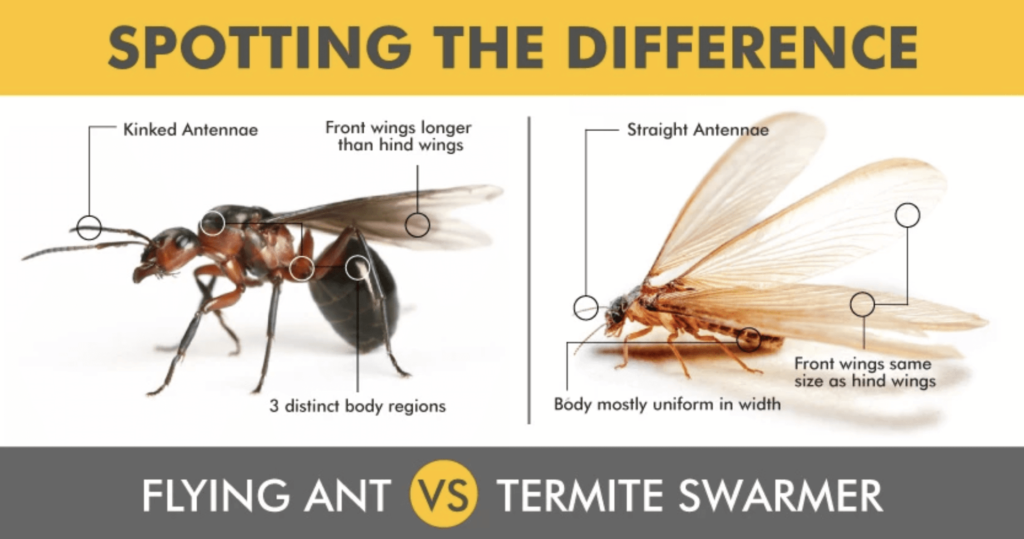By definition, “swarms” are a large or dense group of insects, especially of the flying variety. Termite swarms can also be nightmare fuel or the beginning plotline for a horror flick when witnessed in or near your home! In this article, we will give you some advice and tips on what you should know and look out for to identify a termite swarm.
First signs of a termite swarm
Swarmers are juvenile female and male winged termites, also known as alates. Termite swarmers emerge from their nests in the spring to mate and look for a place to establish a new colony. They swarm out from areas in which they already have an established feeding area, which usually includes our homes.
When termites swarm indoors, they will emerge from small gaps in walls or wooden construction like door frames, baseboards, and posts. A termite swarm will usually last for only about 30 to 40 minutes. They will try to fly towards a light source which is typically around windows and other areas like sliding glass doors.
If these young termites can’t find a way out to find soil, they will die within a few hours due to dehydration. Dead termite swarmers, or their discarded wings near doors, window sills, counter tops, etc., are often the only visible sign you might see to let you know you have a potentially serious termite problem.
Termites swarm season is in spring.
Huge numbers of winged termites usually appear within homes during the springtime. Termites swarm in nature to scatter and create new colonies. These termites emerge from the colony and migrate into the air as a result of warmer temperatures and rainfall. Swarmers then fall to the ground, shed their wings, pair up with a mate, and try to establish new colonies in the soil.
Swarms of termites emerging from tree stumps, woodpiles, and other structures in the yard are not generally cause for alarm and do not necessarily suggest that the house is infested. It is, however, a sign that there is termite activity nearby. If swarmers are emerging next to your foundation or from adjacent porches and patios, it is highly likely that your home or building has a termite infestation.
Are they termites or flying ants?
The presence of winged termites indoors signals an infestation that usually requires treatment. Since swarmers are drawn to light, they are often seen near windows and doors. People sometimes associate winged termites with ants, which can swarm at the same time of year. Below we have some key ways to differentiate between winged termites and carpenter ants.
3 Main Differences Between Termites and Flying Ants:

Straight or Bent Antennae?
- A close inspection of a carpenter ant’s antennae shows that they are curved.
- The antennae of termites are straight. They are even shorter than the antennae of carpenter ants.
Uniform Width or Distinct Body Regions?
- Every insect has three body parts: the head, the thorax, and the abdomen. These regions, however, are not necessarily noticeable in all insects.
- The width of termites’ bodies seems to be somewhat uniform (the three regions are not apparent). Carpenter ants’ bodies have three distinct areas that you can see.
Wings: The Same or Different Length?
- Carpenter ants and termites each have two pairs of legs, with a total of four. There are two pairs: one in front and one in back of the body. Both the front and back pairs of wings on termites are the same length. The back wings of carpenter ants are slightly shorter than the front wings.
- Termites’ and carpenter ants’ wings appear to go straight back, making it nearly impossible to tell whether they’re the same length. However, you should be able to see the colors of the wings.
- Carpenter Ant wings are brown in color.
- Termite wings are transparent and white.
Do termite swarmers mean you have a termite infestation?
Termite swarmers are mainly a seasonal nuisance but they indicate that a termite colony, which includes termites that feed year round, has already breached the envelope of your house or building.
The majority of termite colonies stay hidden, actively eating wood or other cellulose-containing materials they come across and bringing digested cellulose to their nest mates to fuel the colony. This feeding activity has the potential to seriously harm wooden structural components as well as other cellulosic furnishings within a building.
Contact Our Termite Control Specialists
Termite colonies can inflict thousands of dollars in damage to a house, so it’s important to be proactive if you discover their activity. If you’ve discovered a termite swarm either inside or outside near your home, contact a Procor Pest Control expert so we can assess your situation and determine if there’s any termite damage to your property, signs of termite activity or colony nearby.